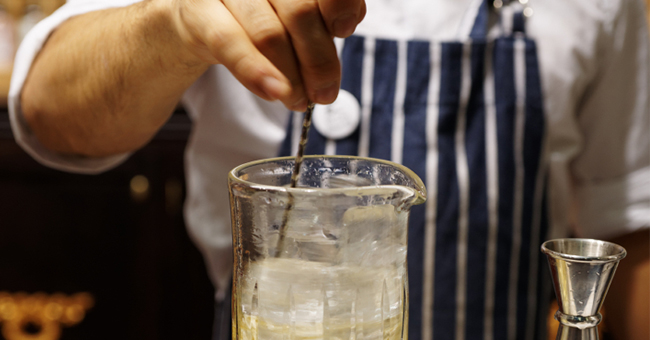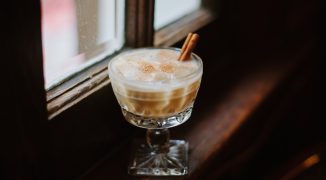Fastidious attention to detail, kodawari, is a much-lauded characteristic of Japanese culture. Craftsmanship, it is assumed, is taken seriously there, expressed in the intricate way of tea and, more recently, coffee. Japanese perfection of foreign imports, too — American jeans, French cuisine — has been a staple curiosity of the international press for a while now. Perhaps then, only Japan could take something so seemingly simple as a whiskey highball and elevate it to an art form.
In our recent interview, GreenRiver head bartender Julia Momose described the art of the Japanese highball: “it’s about taking a beautiful, clean highball glass, adding a little bit of liquid, a little bit of ice, a little more liquid, a little more ice …” This got us wondering about the ritual. Our research yielded some interesting findings, including that proper preparation requires a very precise number of stirs — thirteen and a half stirs of the whiskey, followed by another three and a half of the cocktail.
When asked to clarify, Momose said that it is important to make the distinction between a whiskey highball, whiskey and sparkling water in a tall glass over cut ice; and a mizuwari, the careful, ritual of building ice, whiskey and mineral water in a chilled glass. “I think of mizuwari as a form of a highball cocktail,” Momose said, “a very, very specific form.”
Starting with a tall glass and hand-cut ice with no ice bubbles or minerals, Momose’s method for the mizuwari is as follows: “Stir a single piece of carved ice in the glass until the sides start to chill. Pour off the melted water. Pour a measure of whiskey over the ice, add one more piece to bring the liquid and ice to a level point in the glass, and stir thirteen and a half times, clockwise. Add the third piece of ice, and top off with two-thirds of a measure of mineral water. Stir clockwise, three and a half times. Nestle the bar spoon underneath the base of the ice, and lift upwards to fully homogenize the whiskey and water. Without jostling or stirring the drink any further, softly draw the spoon from the glass. Serve.”
“The beauty of this tradition is in the simplicity and control of each element,” she said. “It is about being in the moment, accepting the natural way in which the ice cracks, selecting the perfect piece to be the cornerstone of the drink.”
But, mizuwari or regular whiskey highball, how common is such a labor-intensive technique? Gardner Dunn, national brand ambassador for Suntory, told us that while it is rare to see such an intense method of highball preparation in Japan, “there is kind of an art form to it. It’s not just a whiskey soda.”
Shinya Yamao, the Japan-born bar manager of Piora in New York City told us “there is a very exacting way to making a good highball, but it’s kind of a different drink now.”
“Maybe if you go to a high-end bar and there’s a professional bartender there making a great highball, maybe he’s going to use a great single malt and stir it a certain way, add the ice a certain way … but by the same token, there’s some people who just want to have a whiskey soda. It’s like fast food, you can go to a real burger place and pay $20 for a burger, or you can pick up a Burger King.”
When mixing a highball himself, Yamao says that he does not count the number of stirs. The method of preparing the drink, he said, depends on a number of factors – glass temperature, size and shape of the ice, guest tastes and room temperature. One supreme method cannot be so simply prescribed. “It’s more of a bartender’s sense or feeling,” he says. “Like sushi, you can start with the same fish and the same rice, but two different sushi chefs will make something different.”
Julia Momose agrees. “I like to think that each bartender may take it upon themselves to be in the moment when creating the drink,” she said, “and let the ice, the water, and the whiskey meld as they will. On a hotter day, I would suggest more chilling (and) less stirring once all of the elements are incorporated, as the ambient temperature has a great effect on the drink as well. Everything in that single moment matters and changes each time.”
Thanks largely to Suntory founder Torii Shinjiro and his chain of Tory’s bars, the highball became a popular way to enjoy whiskey in Japan in the 1950s. “It brought the proof down to that of beer, opened up the whiskey in new ways, and made it more enjoyable with food,” said Momose. Following its mid-century heyday, however, the highball came to be perceived as an old man’s drink and fell fast out of fashion. Whiskey itself lost its appeal when Japan’s ‘bubble’ economy burst in the early nineties, causing belts and expense accounts to tighten — post-work visits to pricey hostess clubs, where expensive whiskey bottles would sit on each table, became less frequent. “Young people were more interested in drinking shōchū or beer — easier drinks than whiskey,” said Yamao.
In the last few years, however, the whiskey highball has swept Japan. Its resurgence can be traced back to 2009 when Suntory released a TV commercial featuring Japanese actress Koyuki enthusiastically enjoying the drink from a branded mug. Soon afterward, Suntory opened a series of dedicated highball bars, devised equipment to dispense premixed highballs on tap, and launched canned versions of the drink in Japanese convenience stores. Chū Hi, a canned shōchū highball, has been available in Japanese stores for years, so perhaps the canned whiskey highball was inevitable.
“Instead of draft beer, people are (now) drinking highballs,” said Yamao, adding that the highball’s popularity has the added benefit of opening consumers up to the world of Japanese whiskey.
Just a month ago, Yamao introduced the highball on tap concept to Piora, the first bar, he believes, in New York to do so. Yamao’s draft highball is prepared with a blend of Nikka Coffey Grain Whisky and Nikka Taketsuru Pure Malt with a touch of lemon. The Coffey Grain adds a hint of sweetness to a drink that makes for a refreshing, low alcohol, lighter alternative to a beer.
A highball dispensed from a keg may not be the idealized expression of Japanese craftsmanship, but it works. “I can make a better highball,” Yamao said, “but I also like it like this.”





